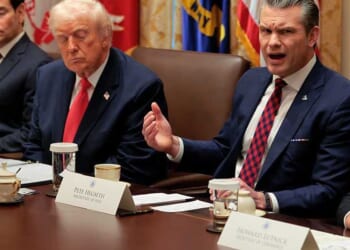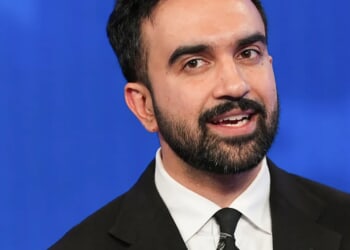TRUMP: ‘I JUST FELT IT WAS TIME’: His peace overtures rebuffed by Russian President Vladimir Putin yet again, President Donald Trump reluctantly ordered what he called “massive sanctions,” on Russia’s two biggest oil companies, Rosneft and Lukoil, in the hope that targeting Putin’s primary source of income will force him to agree to freeze the Ukraine war at the current battle lines.
“These are tremendous sanctions. These are very big against their two big oil companies,” Trump said in a social media post by the White House. “And we hope that they won’t be on for long. We hope that the war will be settled.”
“They’re massive sanctions,” Trump said during an Oval Office sit-down with NATO Secretary-General Mark Rutte. “They do a lot of oil. And hopefully it will push, hopefully he’ll [Putin] become reasonable, and hopefully Zelensky will be reasonable too.”
Trump continues to blame the hatred Ukrainian President Volodymyr Zelensky holds for Putin, who has spent nearly four years killing tens of thousands of Ukrainians, kidnapping more than 20,000 children, and in his failed bid to take over Ukraine. “These two people hate each other … and it makes it more difficult than it should be,” Trump said. “It takes two to tango, as I say. And we’re going to find out.”
In imposing the most significant sanctions to date, Trump is refusing to give up on Putin despite an unbroken string of disappointments. “President Putin has not come to the table in an honest and forthright manner, as we’d hoped,” Treasury Secretary Scott Bessent said on Fox, while Trump said he only imposed sanctions as a last resort. “I just felt it was time. We waited a long time.”
“I think that in terms of honesty, the only thing I can say is every time I speak with Vladimir, I have good conversations and then they don’t go anywhere. They just don’t go anywhere,” Trump lamented. “But now, look, he’s fighting a war. He’s in a war that’s two very competent sides, and that’s the way war is. You never know with war. But I would say that it’s time, it’s time to make a deal.”
TOMAHAWKS: TOO ‘COMPLEX’: Trump all but ruled out sending long-range Tomahawk cruise missiles to Ukraine, insisting they are too “complex” a weapons system, and would take up to a year for the Ukrainians to be able to operate them.
“There is a tremendous learning curve with the Tomahawk. It’s a very powerful weapon, very accurate weapon, and maybe that’s what makes it so complex,” Trump said. “It’ll take a minimum of six months, usually a year, to learn how to use them. Highly complex.”
Trump argued the only way to deploy Tomahawks promptly would be to have U.S. troops operate them, and that, he said, is not happening. “The only way a Tomahawk is going to be shot is if we shot it, and we’re not going to do that,” Trump said. “It takes a year of intense training to learn how to use it. And we know how to use it, and we’re not going to be teaching other people. It’s too far out into the future.”
TRUMP DENIES GIVING UKRAINE GREEN LIGHT FOR DEEP STRIKES: In social media posts and in his session with reporters, President Trump took exception with a Wall Street Journal story that said his administration had “lifted a key restriction on Ukraine’s use of some long-range missiles provided by Western allies.”
“The Wall Street Journal story on the U.S.A.’s approval of Ukraine being allowed to use long range missiles deep into Russia is FAKE NEWS! The U.S. has nothing to do with those missiles, wherever they may come from, or what Ukraine does with them!” Trump posted on Truth Social.
“It said that I gave Ukraine permission to shoot missiles deep into Russia. I didn’t do that,” Trump later elaborated. “They’re not using our missiles. They’re using, I think, European missiles or from some place, but they’re not using ours. And what they do, I don’t control that. But I do control our missiles. They’re not shooting our missiles. It was a fake story.”
“This is not what we reported,” Dave Brown, the Wall Street Journal’s Deputy Washington Coverage Chief, posted on X. “Our story says authority for supporting long-range attacks has moved from SECDEF to EUCOM. Plus, the U.S. can restrict Ukraine’s use of Storm Shadow because the missiles use American targeting data.”
A careful reading of the story suggests Trump either didn’t read or didn’t grasp the nuance of the report.
“The Storm Shadow relies on U.S. intelligence to hit its targets. Beginning last spring, the Pentagon insisted on reviewing Ukraine’s use of long-range missiles, including Storm Shadow, to strike inside Russia,” the Wall Street Journal reported. “Under the mechanism, the defense secretary had final say over whether Ukraine could employ Western long-range weapons to strike Russia. No attacks were approved until recently, when authority for approving such attacks was returned to European Command,” the newspaper cited two U.S. officials as saying.
Earlier this week, Ukraine’s General Staff announced it had used British Storm Shadow missiles in a successful attack on a Russian chemical plant.
“Ukraine’s renewed use of Storm Shadows isn’t a game changer on the battlefield. They have a far shorter range than U.S. Tomahawks, and have been used to strike targets in Russia before. But the missiles do enable Kyiv to expand its attacks inside Russia,” the Wall Street Journal report said.
US ALLOWS UKRAINE TO USE WESTERN CRUISE MISSILE FOR STRIKES INSIDE RUSSIA: REPORT
Good Thursday morning and welcome to Jamie McIntyre’s Daily on Defense, written and compiled by Washington Examiner National Security Senior Writer Jamie McIntyre (@jamiejmcintyre) and edited by Christopher Tremoglie. Email here with tips, suggestions, calendar items, and anything else. Sign up or read current and back issues at DailyonDefense.com. If signing up doesn’t work, shoot us an email and we’ll add you to our list. And be sure to follow me on Threads and/or on X @jamiejmcintyre.
CLICK HERE TO SIGN UP OR READ BACK ISSUES OF DAILY ON DEFENSE
TRUMP: EVERY DRUG BOAT ATTACK ‘SAVES 25,000 AMERICAN LIVES’: Last night, War Secretary Pete Hegseth announced on X the ninth known strike against alleged drug smugglers, the second in two days in the in the eastern Pacific Ocean, as President Trump’s war on drug trafficking expands beyond the Caribbean.
Three people were killed in the latest strike, bringing the officially acknowledged death toll to 37. The video released by the Pentagon, for unexplained reasons, had the cargo area of the small boat grayed out before a missile blasted the boat and set it ablaze. “These are not simply drug runners — these are narco-terrorists bringing death and destruction to our cities,” Hegseth said in his post. “The vessel was known by our intelligence to be involved in illicit narcotics smuggling, was transiting along a known narco-trafficking route, and was carrying narcotics.”
While Democrats in Congress have called the recent strikes illegal, President Trump continues to assert he has broad authority to use lethal force against narcoterrorists in the name of U.S. national security. “We know the people coming in. We know the boats. We know everything else. We’re allowed to do it. It’s in international waters. If we don’t do it, we’re going to lose hundreds of thousands of people.”
“And the way I look at it … it’s amazing that the weaponry,” Trump said. “One shot, everyone dead center … And whenever I see that, I say to myself, I just saved 25,000 lives … Every one of those boats that gets knocked out is saving 25,000 American lives.”
US CONDUCTS FIRST KNOWN STRIKE IN EASTERN PACIFIC TARGETING ALLEGED CARTEL VESSEL
‘THEY WILL BE HIT ON LAND ALSO’: Trump keeps making veiled references to expanding the counter narcotics efforts to “land,” putting Venezuela and Colombia in the crosshairs. During his session with reporters on Wednesday, Trump singled out Colombian President Gustavo Petro, who has accused the U.S. of murdering a “humble fisherman” in a strike last week.
“He’s a thug. And he’s a bad guy. And he’s hurt his country very badly. They’re doing very poorly, Colombia. They make cocaine. They have cocaine factories. They grow all sorts of crap. That’s drugs, bad drugs, coming into the United States,” Trump said. “And he better watch it. It will take very serious action against him and his country.”
Trump also threatened to attack drug cartels in Venezuela. “We will hit them very hard when they come in by land. And they haven’t experienced that yet, but now we’re totally prepared to do that,” adding that he would likely brief Congress first.
“Something very serious is going to happen. The equivalent of what’s happening by sea,” Trump said. “And we’re going to Congress just to tell them what we’re doing, just to keep them informed. We have to do it for national security. We have to do it to save lives.”
THE ‘NEW’ PENTAGON PRESS CORPS: Chief Pentagon Spokesman Sean Parnell gleefully announced yesterday that building access is being granted to a new crop of Pentagon reporters, made up almost exclusively of right-wing bloggers, newsletter authors, and activists.
“We are excited to announce over 60 journalists, representing a broad spectrum of new media outlets and independent journalists, have signed the Pentagon’s media access policy and will be joining the new Pentagon press corps,” Parnell said in a post on X. “We look forward to beginning a fresh relationship with members of the new Pentagon press corps.”
Parnell, who is also the chief antagonist of the reporters who have covered the building for decades — and who gave up their building passes because of restrictions on where they could go and who they could talk to — denounced the “mainstream” journalists with inventive dripping with disdain.
Parnell called them “self-righteous media” and “activists who masquerade as journalists” and said the new media outlets would “circumvent the lies of the mainstream media and get real news directly to the American people.”
The new media includes Timcast, The National Pulse, Washington Reporter, The Post Millennial, Just the News, Human Events, TPUSA Frontlines, Lindell TV, the Daily Signal, and the Gateway Pundit.
But the old press corps isn’t going anywhere. They are all continuing to cover the defense beat; they just don’t have desks in the building anymore. However, given that there are few briefings and highly restricted access, that doesn’t seem like much of a loss.
CLICK HERE TO READ MORE FROM THE WASHINGTON EXAMINER
THE RUNDOWN:
Washington Examiner: US conducts first known strike in eastern Pacific targeting alleged cartel vessel
Washington Examiner: Trump administration’s decision to repatriate survivors of US strike in Caribbean Sea raises red flags
Washington Examiner: Rubio to become latest US official to travel to Israel to support ceasefire efforts
Washington Examiner: Israel’s right-wing votes for Israeli sovereignty in West Bank, ignoring Netanyahu’s opposition
Washington Examiner: Thune teases shutdown votes to pay troops and air traffic controllers
Washington Examiner: Newsom deploys National Guard to aid food banks during shutdown
Washington Examiner: Top House GOP appropriator concedes Congress will need new spending deal
Washington Examiner: Shipbuilders, port authorities hit in fallout of Trump’s attacks on offshore wind
Washington Examiner: ‘‘Sandwich guy’ asks court to drop charges for assaulting CBP agentSandwich guy’ asks court to drop charges for assaulting CBP agent
Washington Examiner: Panetta calls Hegseth address to senior leaders ‘waste of time’
Washington Examiner: Federal agents deploy to San Francisco area in latest illegal immigration crackdown
Washington Examiner: US allows Ukraine to use Western cruise missile for strikes inside Russia: Report
Washington Examiner: Opinion: Russia’s not-so-secret Orthodox weapon
Wall Street Journal: U.S. Lifts Key Restriction on Ukraine’s Use of Western Long-Range Missiles
AP: Putin directs drills of Russian nuclear forces as his summit with Trump is put on hold
Reuters: Sweden and Ukraine Eye Export Deal for up to 150 Gripen Fighter Jets
Air Force Times: US, Europe Fly the Same Jets, but Can’t Always Fix Each Other’s: Rand
Washington Post: Russia duped West for its tech
New York Times: The Submarines That Smuggle Cocaine Across Oceans and Seas
Wall Street Journal: Islamic State Rises Again in Syria, Filling a Void Left by US
The Atlantic: Holy Warrior: Pete Hegseth is bringing his fundamentalist interpretation of Christianity into the Pentagon.
Air & Space Forces Magazine: Northrop Checks Off Sentinel Milestones While Still Working on Program Restructure
Defense One: As Space Weapons Proliferate, Spy Satellites Are Getting New Duties
The War Zone: AeroVironment’s Freedom Eagle-1 Picked as New Counter-Drone Interceptor for US Army
Air & Space Forces Magazine: Experts: US Needs Whole-of-Government Approach to Match China in Cislunar
Flying Magazine: Air Force Taps Merlin to Refine Aircraft Autonomy
Air & Space Forces Magazine: Air Force to Inspect All Dorms for ‘Clean, Comfortable, Safe’ Living Conditions
New York Times: Book Review: The Connection Between the Fort Bragg Cartel and the ‘Department of War’
THE CALENDAR:
THURSDAY | OCTOBER 23
8 a.m. — Atlantic Council virtual seminar: “Countering the PRC Gray-Zone Strategies,” with Jay Tarriela, Philippine Coast Guard spokesperson; Ta-Chen Chen, Research Institute for Democracy, Society and Emerging Technology non-resident fellow; and Arielle Ann Nicole Lopez of the National Defense College of the Philippines Senior Defense Research Office https://www.atlanticcouncil.org/event/countering-the-prcs-gray-zone-strategies
9 a.m. — Center for Strategic and International Studies virtual discussion: “U.S.-China Trade War,” with Matthew Goodman, Council on Foreign Relations fellow for geoeconomic studies; Dennis Wilder, Georgetown University senior fellow; Philip Luck, CSIS chair in international business; Victor Cha, CSIS Korea chair; and Mark Lippert, CSIS nonresident senior adviser https://www.csis.org/events/us-china-trade-war-capital-cable-123
11 a.m. — Center for a New American Security virtual discussion on a new report: “Stuck in the Cul-de-Sac: How U.S. Defense Spending Prioritizes Innovation Over Deterrence,” with co-author Carlton Haelig, CNAS fellow; co-author Philip Sheers, CNAS research associate; Todd Harrison, American Enterprise Institute senior fellow; and Susanna Blume, CNAS senior fellow https://www.cnas.org/events/virtual-event-stuck-in-the-cul-de-sac
12 p.m. 37th and O Sts. NW — Georgetown University Center for Muslim-Christian Understanding and Center for Contemporary Arab Studies discussion: “The Trump-Netanyahu Peace Plan for Gaza: A Critical Appraisal ,” with Diana Buttu, professor at Georgetown University Qatar https://events.georgetown.edu/sfs/event/33345-the-trump-netanyahu-peace-plan
2 p.m. — Mitchell Institute for Aerospace Studies virtual discussion: “Air Mobility ,” with Air Force Gen. John Lamontagne, commander, Air Mobility Command; and retired Lt. Gen. David Deptula, dean, Mitchell Institute for Aerospace Studies https://www.mitchellaerospacepower.org/events/gen-john-lamontagne/
FRIDAY | OCTOBER 24
10 a.m. — National Institute for Deterrence Studies virtual seminar: “Russia’s Evolving Tactical and Theater Nuclear Posture ,” with Phillip Karber, professor of strategy and praxis at the National Defense University https://thinkdeterrence.com/events/russias-evolving-tactical-theater-nuclear-posture
WEDNESDAY | OCTOBER 29
11 a.m. Charlottesville, Virginia — University of Virginia Miller Center in-person and virtual discussion: “AI, national security, and democratic accountability,” with Ashley Deeks, Miller Center faculty senior fellow, and vice dean of the University of Virginia School of Law; Brian Lessenberry, senior national security practitioner; and Philip Potter, Miller Center faculty senior fellow https://millercenter.org/news-events/events/ai-national-security-and-democratic-accountability















